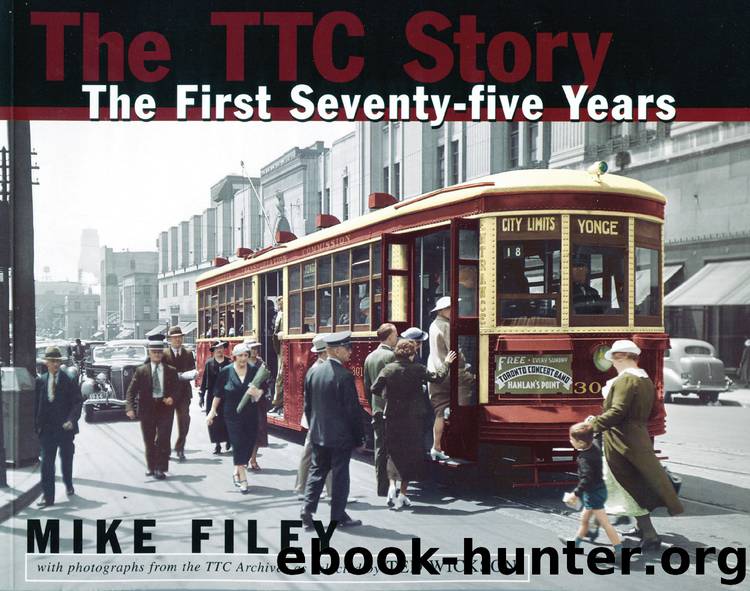The TTC Story by Mike Filey

Author:Mike Filey
Language: eng
Format: epub
Publisher: Dundurn
Published: 1996-02-28T16:00:00+00:00
First day subway transfer.
Later that afternoon the last of the Witt “trains” rattled and rumbled over the Yonge route ending a service that had originally started with horsecars back in 1861. For the trivia buffs the very last “train” was made up of motor 2574 and trailer 2897.
Initial cost estimates for the city’s first subway are difficult to determine since the figures for construction of the second route, Queen, are frequently included. However, according to a Toronto Telegram editorial that appeared on the same day the subway opened, approximately $29 million is given as the “original” estimate for the Yonge route. This figure is then contrasted with the 1954 estimate of $59 million which is itself $8 million short of what the $67 million figure now provided in TTC reference material.
The Yonge line had only been in operation for a month when a fascinating story appeared in the press that revived a 1943 plan that proposed the city build a combined rapid transit line–multi-lane superhighway paralleling Bloor Street and Danforth Avenue. The subway would be 16 kilometers (10 miles) in length with approximately twenty stations between the eastern and western terminals at Victoria Park Avenue and The Kingsway. The expressway would be somewhat longer at 24 kilometers (15 miles), entering the city at the Humber River border with Etobicoke and connecting with Highway 5 in Scarborough. The actual route of the transit line–highway combination would be north of Bloor and Danforth in places and south in others. The plan called for the highway to cross the Don Valley on a new bridge while the transit line would use the lower deck of the Prince Edward Viaduct as predicted by consulting engineers who designed the structure in the early teens with that eventuality in mind. Only part of this imaginative $120 million transit–expressway scheme ever got built and then only in a much modified form. Nevertheless, when the Bloor-Danforth subway finally opened in 1966, it made its way across the valley using that same lower deck in a manner predicted by those far-sighted engineers more than a half-century before.
Although the subway had finally become operational on March 30, many months would go by before Yonge Street itself would be ready and completely reopened to traffic. In fact, it was while work on the rehabilitation of the city’s main thoroughfare was nearing completion that a natural disaster of unparalleled magnitude struck. Violent winds and rain began lashing the community on October 15, and by the time they has subsided the following morning Hurricane Hazel had claimed the lives of more than eighty citizens and caused in excess of $24 million in property damage. The focus of the Yonge Street reopening ceremony, scheduled to be held on October 20, was quickly modified so that, in addition to celebrating the street’s rebirth, it became a fund-raising event with all donations earmarked to assist the hundreds of hurricane victims.
The London tube has a reckless air
As it swooshes down to Leicester Square
In Barcelona they shout “Olé!”
When
Download
This site does not store any files on its server. We only index and link to content provided by other sites. Please contact the content providers to delete copyright contents if any and email us, we'll remove relevant links or contents immediately.
| Automotive | Engineering |
| Transportation |
Small Unmanned Fixed-wing Aircraft Design by Andrew J. Keane Andras Sobester James P. Scanlan & András Sóbester & James P. Scanlan(32570)
Navigation and Map Reading by K Andrew(4884)
Endurance: Shackleton's Incredible Voyage by Alfred Lansing(4496)
And the Band Played On by Randy Shilts(2007)
Wild Ride by Adam Lashinsky(1863)
The Box by Marc Levinson(1856)
Top 10 Prague (EYEWITNESS TOP 10 TRAVEL GUIDES) by DK(1845)
The Race for Hitler's X-Planes: Britain's 1945 Mission to Capture Secret Luftwaffe Technology by John Christopher(1738)
The One Percenter Encyclopedia by Bill Hayes(1713)
Trans-Siberian Railway by Lonely Planet(1624)
Girls Auto Clinic Glove Box Guide by Patrice Banks(1615)
Looking for a Ship by John McPhee(1569)
Batavia's Graveyard by Mike Dash(1545)
TWA 800 by Jack Cashill(1519)
Fighting Hitler's Jets: The Extraordinary Story of the American Airmen Who Beat the Luftwaffe and Defeated Nazi Germany by Robert F. Dorr(1511)
Troubleshooting and Repair of Diesel Engines by Paul Dempsey(1495)
Good with Words by Patrick Barry(1493)
Bligh by Rob Mundle(1483)
Ticket to Ride by Tom Chesshyre(1476)
